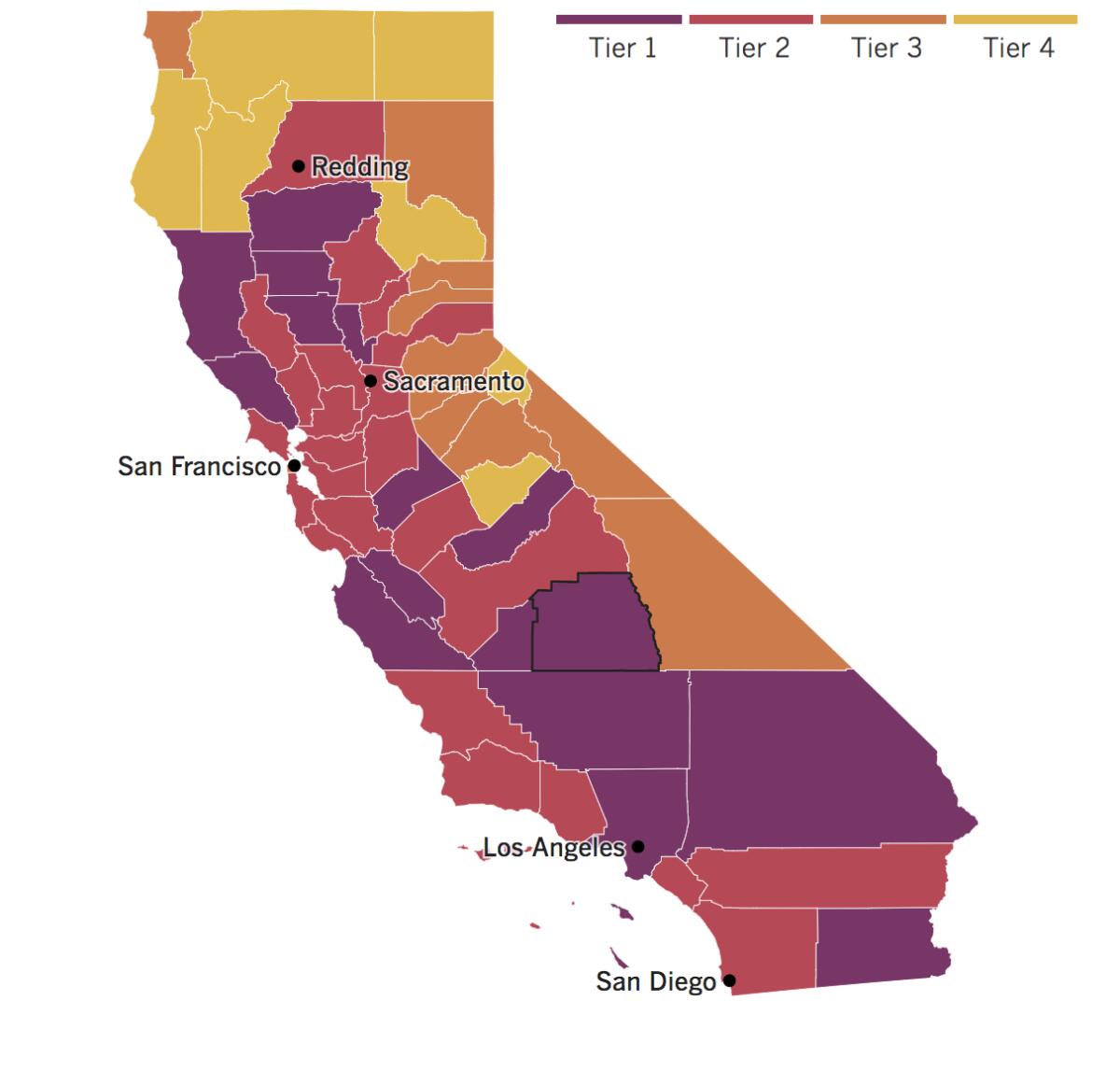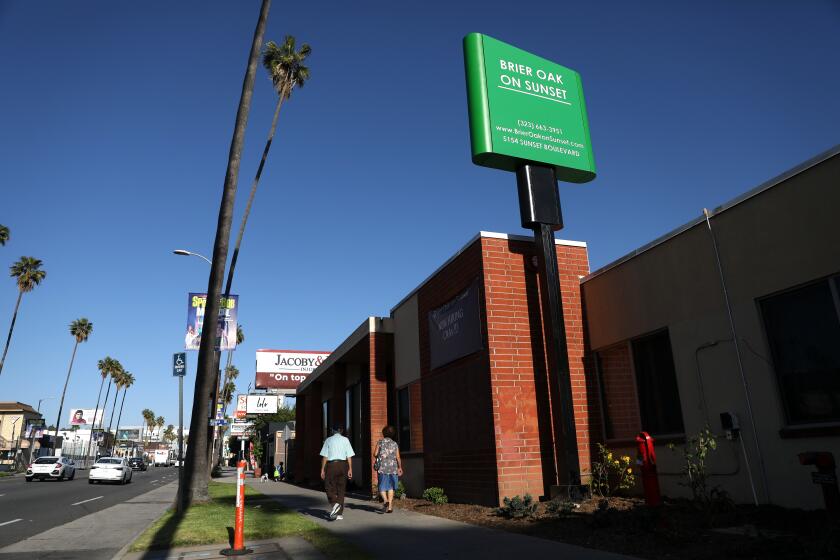Coronavirus Today: The case of the missing contact tracers
- Share via
Good evening. I’m Deborah Netburn (again!), and it’s Thursday, Oct. 8. Here’s what’s happening with the coronavirus in California and beyond.
Last week, Ira Longini, a biostatistician at the University of Florida, told me it could be a month before we fully understand the scope of what he called the “White House Outbreak” of the coronavirus, which so far is responsible for infecting the president, the first lady and at least 10 others.
The reason it may take so long is that it can take weeks for people who have the virus to develop symptoms and see positive results in a test, he said.
This week, my colleague Emily Baumgaertner reports that we may never know the true size of the outbreak. That’s because the White House has relegated its in-house contact tracing duties to an internal team of doctors who are focused on tracking down those who were in close proximity to Trump between the first presidential debate in Cleveland on Sept. 29 and his positive coronavirus test about two days later.
The contact-tracing team is reportedly not reaching out to people who attended the Sept. 26 White House ceremony to nominate Judge Amy Coney Barrett to the Supreme Court, where the virus appears to have been present.
The more than 100 attendees reportedly received rapid tests before being allowed into the event. But when they were there, few observed social distancing practices or wore masks. Videos show some greeting each other with hugs. And several of those in attendance announced positive coronavirus test results over the next few days.
Experts say the decision to not include people at the nomination ceremony in a contact-tracing effort could result in hundreds of additional infections. Attendees probably know from news reports that they might have been exposed, but the many others who have since crossed paths with possibly infected White House staffers or guests may be unaware that they need tests.
Lawrence Gostin, a health law expert at Georgetown University, said there are no federal laws that compel a thorough investigation of the White House outbreak, but that there is an ethical responsibility to conduct one.
“In any other state or jurisdiction, it would be pretty much unthinkable that no one would have the power to contact-trace. But President Trump is in a lawless position,” Gostin said.
By the numbers
California cases and deaths as of 4:38 p.m. PDT Thursday:

Track the latest numbers and how they break down in California with our graphics.
See the current status of California’s reopening, county by county, with our tracker.


Consider subscribing to the Los Angeles Times
Your support helps us deliver the news that matters most. Become a subscriber.
Across California
There have been so many casualties and almost-casualties of this pandemic. Today my colleague Dorany Pineda writes about two beloved local bookstores that have reached out directly to their communities to help keep their doors open. On Monday, Chevalier’s Books, an 80-year-old independent bookstore in Larchmont Village, sent some 3,000 readers an email asking for increased support. Sales had plummeted by 40%, and the store’s landlords announced that they would not be able to extend its lease. The owners located a potential new home across the street, but the rent is twice as much as they are currently paying. “We are now asking you to help keep Chevalier’s Books a part of the Larchmont community,” the store’s owners wrote in an email.
Vroman’s Bookstore in Pasadena made a similar plea on Sept. 28, describing the last few months as “the most difficult in our company’s 126-year history.” “Up until now I have resisted asking for community support — it’s a very humbling experience,” the owner wrote to about 50 friends of the store. “But it is now time.” But this seemingly sad story may just have a happy ending. Both stores said their cries for help were heard loud and clear by their book-loving communities. Sales at Vroman’s flagship store on Colorado Boulevard increased 169% the week of Sept. 25 to Oct. 1 compared with the week before, and the owner said the store has remained crowded since he sent the note.
Chevalier’s experienced a similar show of support. “We’re overrun with sales, we’re selling gift certificates like crazy, and we have all these people offering to help us,” the owner said. “The response has been overwhelming.”
In other news, Gov. Gavin Newsom said that despite Disney’s announcement last week that it will have to lay off 28,000 workers in response to California’s shutdown of all theme parks in the state (among other factors), the attractions will continue to remain closed for now. “We’re going to be led by a health-first framework, and we’re going to be stubborn about it,” the governor told reporters. “We don’t anticipate in the immediate term any of these larger theme parks opening until we see more stability in terms of the data.”
And in Santa Cruz County, a skilled nursing home is suffering a severe outbreak of COVID-19, with 61 people testing positive for coronavirus infections and nine dying of COVID-19, a county health spokeswoman said Thursday. Of the 61 infected at the Watsonville Post-Acute Center, nine were staff. All those who died were residents who ranged in age from their early 70s to their 90s, said Corinne Hyland, a public information officer for the county Department of Public Health. The facility is licensed for 95 beds.
Santa Cruz County health officials have been visiting the facility daily to review protocols on isolation, quarantine, testing and screening, and to respond to requests for more resources.
Resources
— For general safety, wash your hands for at least 20 seconds (here’s a super-fun how-to video). Stop touching your face, and keep your phone clean. Practice social distancing, maintaining a six-foot radius of personal space in public. And wear a mask if you leave home. Here’s how to do it right.
— Watch for symptoms including fever, cough, shortness of breath, chills, repeated shaking with chills, muscle pain, headache, sore throat and loss of taste or smell. If you’re worried you might be infected, call your doctor or urgent care clinic before going there.
— Need a COVID-19 test? Here’s how to receive a free test if you’re in L.A. County. And here’s a map of testing sites across California.
— Here’s how to care for someone with COVID-19, from monitoring their symptoms to preventing the virus’ spread.
— If your job has been affected by the pandemic, here’s how to file for unemployment.
— Here are some free resources for restaurant workers and entertainment industry professionals having trouble making ends meet.
— Advice for helping kids navigate pandemic life includes being honest about uncertainties, acknowledging their feelings and sticking to a routine. Here’s guidance from the CDC.
— In need of mental health services? Here are resources for coping during the crisis from the CDC and the L.A. County Department of Mental Health. L.A. County residents can also call (800) 854-7771 or text “LA” to 741741.
— For domestic violence victims, the pandemic can pose a “worst-case scenario,” advocates say. If you or someone you know is experiencing such abuse, call the National Domestic Violence Hotline at 1-800-799-SAFE (7233) or L.A. County’s hotline at 1-800-978-3600. Here are more ways to get help.
Around the nation and the world
Like everything else this year, the plan for future presidential debates is now in limbo, thanks to the pandemic and Trump’s recent COVID-19 diagnosis. To keep all participants safe, the independent commission that conducts the debates announced Thursday that the candidates would speak from separate locations at their next matchup on Oct. 15. But Trump wasn’t having it. “I’m not going to waste my time on a virtual debate. That’s not what debating is all about,” he told Maria Bartiromo on Fox Business. “You sit behind a computer and do a debate. It’s ridiculous.”
Biden’s team suggested pushing the town-hall-style event to Oct. 22. By then, Trump presumably would be fully recovered and no longer contagious. The president agreed, but insisted that the third and final debate also get pushed back a week, to just before the Nov. 3 election, and that the two events be held in person, reports my colleague Chris Megerian. Biden’s campaign rejected that proposal, so the schedule remains in limbo.
“Trump’s erratic behavior does not allow him to rewrite the calendar, and pick new dates of his choosing,” said Kate Bedingfield, Biden’s deputy campaign manager. “We look forward to participating in the final debate, scheduled for Oct. 22, which already is tied for the latest debate date in 40 years,” she added. “Donald Trump can show up, or he can decline again. That’s his choice.”
In Wisconsin and the Dakotas, many politicians and residents have rejected mask requirements and downplayed the risks of COVID-19 for months. Now those states are leading the country in new cases per capita. North Dakota recorded 770 new cases per 100,000 residents Wednesday, the highest per-capita rate in the country. The state also recorded 24 more deaths, triple its previous single-day record. South Dakota set records Thursday for active cases, hospitalizations and new deaths, and in Wisconsin, health officials plan to open a field hospital at the state fairgrounds to prevent healthcare centers from being overwhelmed by virus cases. And yet, Wisconsin Republicans are challenging Democratic Gov. Tony Evers’ mask mandate in court.
“What worries me is we haven’t learned our lessons,” said Ali Mokdad, a professor of health metrics sciences at the University of Washington in Seattle. “People let down their guard. They said, ‘It’s not us. It’s big cities.’ But eventually, like any other virus, it’s going to spread. Nobody lives in a bubble in this country.”
The pandemic’s toll continues to affect the entertainment industry. Today, my colleague Ryan Faughnder reports that substantial layoffs are coming to AT&T-owned entertainment giant WarnerMedia as the company continues to restructure its business. The layoffs could result in the loss of thousands of jobs.
And finally, people in Brazil are expressing serious coronavirus fatigue, even as the country surpassed 5 million confirmed cases on Wednesday night and is verging on 150,000 dead. “We take care of the people who are sick with COVID, but something that isn’t discussed is that there’s a very serious disease all over the world, which is depression,” said one nurse technician. “It’s not just the virus that kills.”
Your questions answered
Today’s question comes from readers who want to know: Is pink eye a sign that someone has COVID-19?
A lot of people have been wondering about this since noticing that Mike Pence’s left eye looked decidedly pink at the vice presidential debate Wednesday night, even though he has said he tested negative for the coronavirus.
Conjunctivitis, commonly called pink eye, has many potential causes and its cause cannot be diagnosed properly without knowing a patient’s medical history or conducting an in-person ophthalmic examination, said Dr. Kathryn Colby, chair of the Department of Ophthalmology at NYU Langone Health.
Pink eye is usually caused by either a bacterial or viral infection. Among the most common causes of the ailment are the same adenoviruses that can give someone a cold, she said.
COVID-19 has been associated with conjunctivitis, but it is not a common association, Colby said. She noted that in the early days of the pandemic, researchers in China reported seeing a small number of COVID-19 patients who also had conjunctivitis, but the condition was relatively rare.
Our reporters covering the coronavirus outbreak want to hear from you. Email us your questions, and we’ll do our best to answer them. You can find more answers in our Frequently Asked Questions roundup and in our reopening tracker.
For the most up-to-date coronavirus coverage from The Times over the weekend, visit our homepage and our Health section, sign up for our breaking news alerts, and follow us on Twitter and on Instagram.




